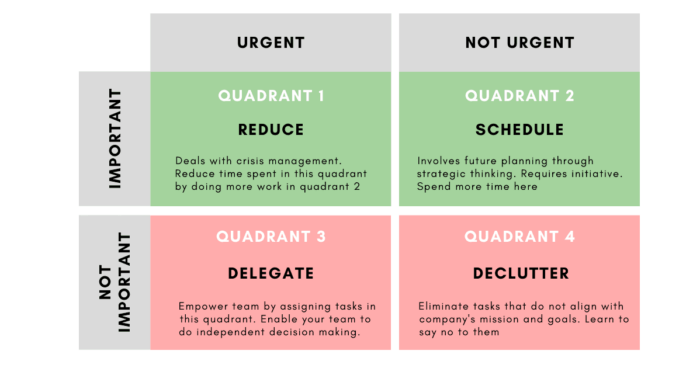Building a company creates a busy schedule. There’s almost no way to avoid it.
But I believe we’re taught to manage our time incorrectly.
From the moment we have homework, soccer practice or piano lessons, we learn that time management means prioritizing what’s on our schedule.
However, as Stephen Covey puts it, the key is to schedule our priorities.
Research shows that only 17% of the population can accurately estimate how much time a task will require.
This is known as the planning fallacy, or “positive bias,” which leads us to vastly underestimate how much time we need to complete each task. For example, we might allocate three hours to write a presentation, then realize that the research alone will take four.
In a University of Waterloo study of positive bias, participants demonstrated the planning fallacy by giving the same time estimations for realistic work scenarios (which inevitably include breaks, challenges, and distractions) as they did for best-case scenarios.
It seems we often have no idea how long a task will actually take. So maybe we should stop estimating altogether.
At my company, Jotform, we almost never assign project deadlines. Producing great work matters more to us than checking a “finished” box. Our teams have the freedom to try new ideas, explore tangents, and find solutions that work for our 4.3 million users — without the clock ticking.
As former U.S. president Dwight D. Eisenhower famously said,
“What is important is seldom urgent and what is urgent is seldom important.”
By conforming to a prescribed schedule (which we rarely estimate well) we can fall into the same trap that comes with to-do lists.
Checking off a never-ending list of to-dos can be a tempting way to avoid important work. And if the scheduled time block for a key task is too short, we’ve already spent our day slaving over a non-essential checklist.
Yet, I’m constantly reminded that the tasks we avoid are usually the most important — and the most likely to help us reach a higher level of productivity.
We can achieve a state of flow — an intensely focused, almost meditative period of concentration — by honing in on critical tasks. But we’re less likely to experience flow under strict time constraints.
Still, we shouldn’t give up entirely on time management.
Instead of relying on a to-do list or inaccurately estimating time blocks, we can schedule the day to achieve our personal peak performance.
Here are three ways to test-drive this approach for yourself.
Step 1: Prioritize the important, rather than scheduling the urgent
“There’s never enough time to do everything, but there’s always enough time to do the most important thing.” —Brian Tracy
While it may feel daunting to leave your schedule open to energy shifts, this is a crucial aspect of reaching peak performance. But before you can manage your performance, you need to know what to prioritize.
Eisenhower understood the difference between important and urgent tasks. He even developed the Eisenhower decision matrix (which is also called time management matrix) to distinguish between tasks that require immediate attention and those that need time — a distinction that can stunt our productivity when misunderstood.
The decision matrix (which was also popularized by Stephen Covey) has four quadrants. Each quadrant represents a way to qualify tasks.
The first quadrant is the crisis quadrant, where tasks are both urgent and important. Living in Quadrant 1 can lead to stress, burnout, and other problems.
Covey suggests that people who spend the bulk of their time in Quadrant 1 will only find relief in Quadrant 4, where tasks are not important or urgent.
Quadrant 3 represents tasks that are urgent, but not important, such as a survey request that expires the next day. In this quadrant, we can mistake urgency for importance, and tasks are typically based on other people’s expectations and priorities. This is a dangerous place that can quickly waste your time.
Finally, Quadrant 2 includes tasks that are important, but not urgent. As Covey says, “Quadrant 2 is the heart of effective personal management.”
Truly productive workers take care of
By using the matrix to define our tasks, we can begin to understand how much focus, rather than time, each project deserves. As Covey says, “the challenge is not to manage time but to manage ourselves.”
In other words, understanding our own capacity to work productively on a task is more useful than scheduling its duration.
For me, coaching new teams is an important, but not urgent Quadrant 2 task. When we create a new, cross-functional team of 4–5 people, they’re confused and lack direction. I’ve learned that if we leave them alone, their work is often scattered and sub-optimal.
But, if I schedule even 15-minute weekly meetings to discuss their projects, provide direction, and explore how their work matters to the company, they quickly become cohesive and productive.
Step 2: Manage your peaks
Once you know how to identify essential tasks, you can strategize how to achieve peak performance. This is where we can harness our natural energy levels.
We all know when work is flowing. The walls fall away, we’re deeply focused, and our work fascinates us; this is ideal. Obviously, we can’t ignore the urgent (and sometimes monotonous) tasks that keep our companies running, but we can recognize when we’re operating in engaged versus unengaged time.
When we’re engaged and tackling important projects during our peak hours, we’re usually willing to work longer, and we experience less burnout along the way. Minimizing our unengaged time can also boost our energy and drive.
For example, a study by Dale Carnegie found that companies with engaged employees outperform those without by 202%.
Penelope Trunk, a noted career coach and co-founder of Quistic, even suggests that we can divide our time based on what we like to do and what we don’t.
Splitting up your day is a great way to enhance productivity. Use the tasks you enjoy as a reward for completing those that don’t interest you. And if they drag on, move on — spend as much time as you can doing what you enjoy, because those activities probably fall into Quadrant 2.
While we can’t ignore what we don’t enjoy, we can often decide when we do it. The timing of a project can account for up to 20% of cognitive performance variations. Science proves that there are reasons why you might crush a difficult task at 10 am, but struggle to reach the finish line at 3 pm.
According to Daniel Pink, 75% of people experience their days in three stages: a peak, a trough, and a recovery period. The other 25% experience it in reverse: recovery, trough, then peak. By tracking our daily stages, we can discover our own peak performance hours.
Make a spreadsheet and record your energy levels throughout the day. Track how your creativity, focus, and interest ebb and flow, then look for patterns throughout the week.
Once you’ve defined your peak times, you’re ready to capitalize on those precious hours.
Step 3: Pick your strategy
Keep in mind that your professional role can also affect how you work. Paul Graham believes there are 2 kinds of schedules: the maker’s schedule and the manager’s schedule.
A manager’s schedule is run by meetings. Managers typically operate in shorter time bursts, with calendars punctuated by frequent appointments.
Makers, such as writers and programmers, usually struggle to be productive with a manager’s schedule. They need large chunks of time (hours, if possible) to go deep into their work and solve creative problems.
If you’re expected to keep a manager’s schedule, but you work best with a maker’s schedule, Graham suggests creating office hours that let you live in both worlds.
If you’re fulfilled by a manager’s schedule but you’re looking for extra time, consider implementing a meeting margin. For every scheduled meeting, build in an extra 15 minutes for yourself. This can also be a great way to catch up on urgent tasks without allowing them to cut into the important ones.
At Jotform, we try to keep a maker’s schedule, but I recognize that I need to have a hybrid calendar. I build managing hours into the afternoon and work like a maker during the first half of the day. This is when I block in sacred time for deep work.
Scheduling daily, weekly or monthly focused work sessions ensures that you always have space to work well.
You might also try a scheduling system like The Da Vinci Schedule, which fluctuates between hardcore deep work and soft deep work, or build a more personalized schedule with 3 full days of focused working.
Whatever you choose, be sure to prioritize your own peak hours and work that matters, not what your to-do list might dictate.
There’s very little traffic on the extra mile
When we capitalize on our own peak hours, we’re likely to produce higher quality, more consistent work. Plus, we can log extra hours (when necessary) without burning out.
Remember that your peak hours could also change over time. What super-charged your productivity this month might drain your battery next month. So, try to stay in tune with your energy levels and honor these natural shifts.
Evaluate, readjust, and keep moving forward.
You might be amazed by what you can accomplish.
















































Send Comment: